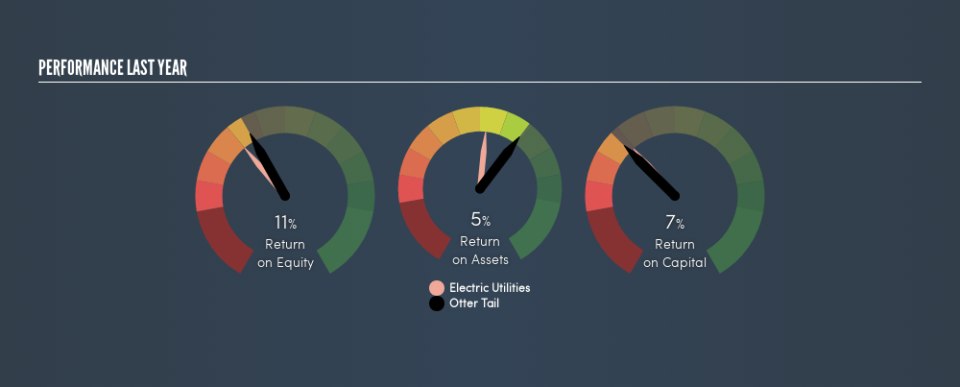Otter Tail Corporation (NASDAQ:OTTR) Is Employing Capital Very Effectively

Today we'll look at Otter Tail Corporation (NASDAQ:OTTR) and reflect on its potential as an investment. To be precise, we'll consider its Return On Capital Employed (ROCE), as that will inform our view of the quality of the business.
First of all, we'll work out how to calculate ROCE. Second, we'll look at its ROCE compared to similar companies. Then we'll determine how its current liabilities are affecting its ROCE.
Understanding Return On Capital Employed (ROCE)
ROCE is a measure of a company's yearly pre-tax profit (its return), relative to the capital employed in the business. In general, businesses with a higher ROCE are usually better quality. In brief, it is a useful tool, but it is not without drawbacks. Renowned investment researcher Michael Mauboussin has suggested that a high ROCE can indicate that 'one dollar invested in the company generates value of more than one dollar'.
How Do You Calculate Return On Capital Employed?
Analysts use this formula to calculate return on capital employed:
Return on Capital Employed = Earnings Before Interest and Tax (EBIT) ÷ (Total Assets - Current Liabilities)
Or for Otter Tail:
0.066 = US$124m ÷ (US$2.1b - US$170m) (Based on the trailing twelve months to December 2018.)
So, Otter Tail has an ROCE of 6.6%.
Check out our latest analysis for Otter Tail
Does Otter Tail Have A Good ROCE?
ROCE is commonly used for comparing the performance of similar businesses. In our analysis, Otter Tail's ROCE is meaningfully higher than the 4.8% average in the Electric Utilities industry. I think that's good to see, since it implies the company is better than other companies at making the most of its capital. Aside from the industry comparison, Otter Tail's ROCE is mediocre in absolute terms, considering the risk of investing in stocks versus the safety of a bank account. Investors may wish to consider higher-performing investments.
When considering ROCE, bear in mind that it reflects the past and does not necessarily predict the future. Companies in cyclical industries can be difficult to understand using ROCE, as returns typically look high during boom times, and low during busts. This is because ROCE only looks at one year, instead of considering returns across a whole cycle. Future performance is what matters, and you can see analyst predictions in our free report on analyst forecasts for the company.
What Are Current Liabilities, And How Do They Affect Otter Tail's ROCE?
Current liabilities are short term bills and invoices that need to be paid in 12 months or less. Due to the way ROCE is calculated, a high level of current liabilities makes a company look as though it has less capital employed, and thus can (sometimes unfairly) boost the ROCE. To check the impact of this, we calculate if a company has high current liabilities relative to its total assets.
Otter Tail has total liabilities of US$170m and total assets of US$2.1b. As a result, its current liabilities are equal to approximately 8.3% of its total assets. With low levels of current liabilities, at least Otter Tail's mediocre ROCE is not unduly boosted.
The Bottom Line On Otter Tail's ROCE
Based on this information, Otter Tail appears to be a mediocre business. Of course, you might also be able to find a better stock than Otter Tail. So you may wish to see this free collection of other companies that have grown earnings strongly.
If you are like me, then you will not want to miss this free list of growing companies that insiders are buying.
We aim to bring you long-term focused research analysis driven by fundamental data. Note that our analysis may not factor in the latest price-sensitive company announcements or qualitative material.
If you spot an error that warrants correction, please contact the editor at editorial-team@simplywallst.com. This article by Simply Wall St is general in nature. It does not constitute a recommendation to buy or sell any stock, and does not take account of your objectives, or your financial situation. Simply Wall St has no position in the stocks mentioned. Thank you for reading.

